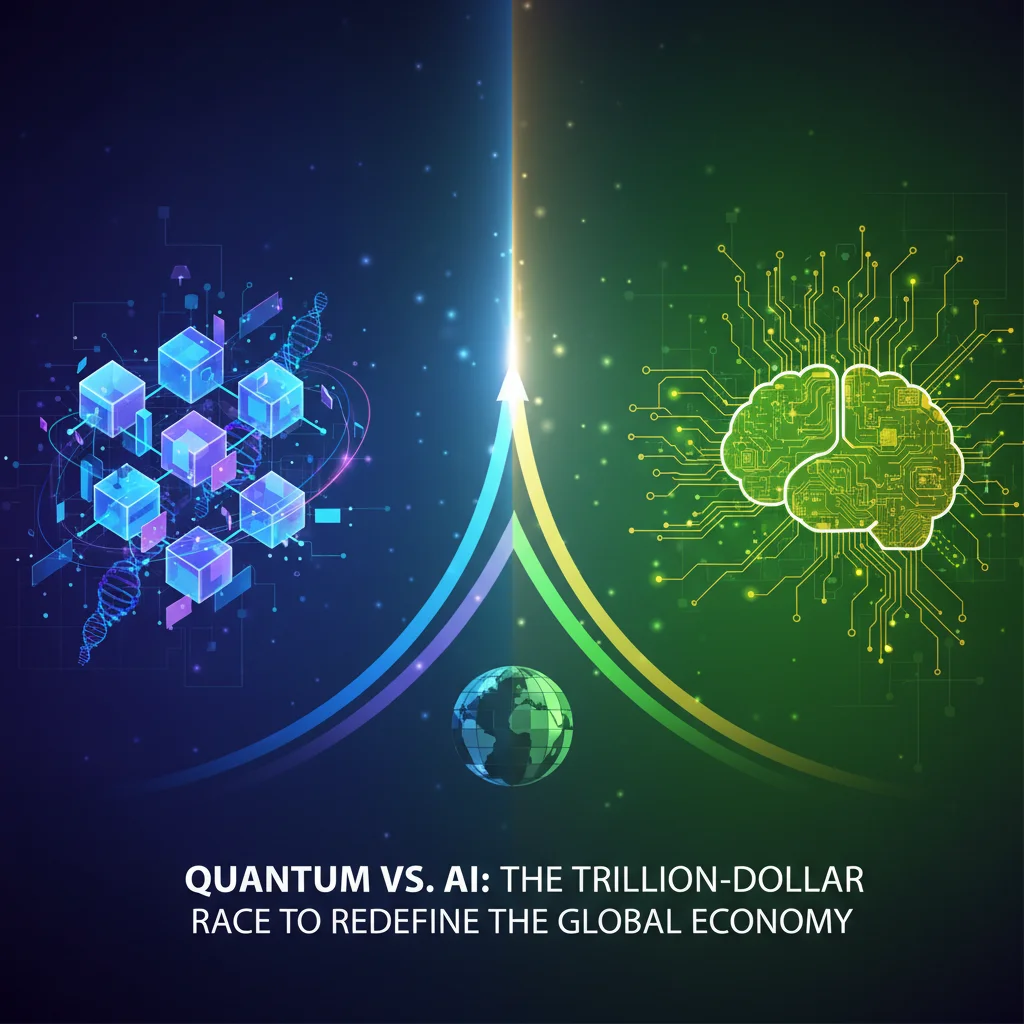
Quantum vs. AI: The Trillion-Dollar Race to Redefine the Global Economy
The world is captivated by Artificial Intelligence. From generative AI creating stunning art to large language models transforming how we work, AI’s impact is immediate, tangible, and dominating investment conversations. It’s the undisputed heavyweight champion of modern technology. But on the horizon, a challenger is emerging from the strange and wonderful world of quantum physics—a technology so powerful it promises to solve problems currently deemed impossible. This challenger is quantum computing.
The question on the minds of visionary investors, business leaders, and economists is no longer just “What’s next for AI?” but rather, as the BBC recently posed, “Will quantum be bigger than AI?” This isn’t just a technological debate; it’s a fundamental question about the future of finance, the stability of our global economy, and the next frontier of human progress. To understand the answer, we must first appreciate the distinct power each technology holds and how their convergence could reshape our world.
The AI Revolution: The Power We Can See and Touch
Artificial Intelligence, in its current form, is a master of learning from the past. It thrives on data, identifying patterns, making predictions, and automating complex tasks with superhuman speed and accuracy. For the financial world, AI is not a future promise; it’s a present-day reality driving immense value.
The global AI market is already a behemoth, valued at hundreds of billions and projected to soar past a trillion dollars in the coming years. This explosive growth is fueled by its profound impact on nearly every facet of the financial industry:
- Algorithmic Trading: AI models analyze stock market data in microseconds, executing trades based on complex predictive models that far exceed human capability.
- Risk Management: Banks and financial institutions use AI to analyze vast datasets for credit scoring, fraud detection, and assessing market risk, saving the industry billions in potential losses.
- Fintech Innovation: From personalized robo-advisors managing investment portfolios to AI-driven customer service bots, financial technology is being fundamentally reshaped by machine learning.
AI’s strength lies in its ability to optimize existing systems based on historical data. It is an engine of immense efficiency and prediction. However, it has limitations. AI struggles with problems that lack vast training datasets or involve a combinatorial explosion of possibilities—problems where the number of potential outcomes is too large for even a supercomputer to simulate. This is precisely where quantum computing enters the stage.
Demystifying Quantum Computing: The Dawn of a New Reality
If classical computing is a light switch (either on or off, a 1 or a 0), quantum computing is a dimmer switch that can be on, off, and every shade in between, all at the same time. This is the magic of the “qubit.”
Unlike a classical bit, a qubit can exist in a state of superposition, representing both 0 and 1 simultaneously. Furthermore, qubits can be entangled, meaning their fates are linked, no matter the distance separating them. This allows quantum computers to process a colossal number of possibilities in parallel. While a classical computer checks every path in a maze one by one, a quantum computer can explore every path at once.
This capability unlocks the potential to solve a class of problems that are currently intractable. According to a McKinsey report, quantum computing is expected to generate trillions of dollars in value across industries like pharmaceuticals, chemicals, automotive, and, crucially, finance.
For the financial sector, the implications are staggering:
- Portfolio Optimization: Today’s portfolio models are a trade-off, simplifying the countless variables that affect the stock market. A quantum computer could analyze the complex interplay between every asset, every economic indicator, and every geopolitical risk in real-time to construct a truly optimal portfolio.
- Financial Modeling: Complex derivatives pricing and risk simulations, like Monte Carlo simulations, can take hours or days on the best supercomputers. A fault-tolerant quantum computer could run them in minutes, giving traders and banks an unprecedented ability to model the economy and hedge against risk.
- The Cryptography Threat: This is the double-edged sword. The very mathematics that underpins the security of modern banking, financial transactions, and even blockchain technology could be broken by a sufficiently powerful quantum computer. The race is now on to develop “quantum-resistant” cryptography to secure our digital economy before this threat materializes. A report from the U.S. National Institute of Standards and Technology (NIST) highlights the urgency, as they are already standardizing the first generation of quantum-resistant algorithms.
To better understand the differences, let’s compare these computational paradigms:
| Attribute | Classical Computing | Artificial Intelligence (AI) | Quantum Computing |
|---|---|---|---|
| Basic Unit | Bit (0 or 1) | Neural Networks (using bits) | Qubit (0, 1, or both) |
| Core Principle | Linear, sequential processing | Pattern recognition from data | Parallelism via superposition & entanglement |
| Best For | Defined, logical tasks (e.g., spreadsheets) | Prediction & optimization (e.g., fraud detection) | Complex simulation & optimization (e.g., drug discovery) |
| Finance Example | Running banking software | Algorithmic stock market trading | Hyper-realistic economic modeling & risk analysis |
The Investment Horizon: Navigating Two Tectonic Shifts
For investors, finance professionals, and business leaders, the strategies for AI and quantum are vastly different, reflecting their different stages of maturity.
Investing in the AI Super-Cycle
AI is a mature and accessible investment class. Opportunities abound, from publicly traded tech giants (NVIDIA, Google, Microsoft) and specialized software companies to a universe of ETFs providing broad exposure to the sector. The infrastructure, software, and application layers are well-defined, and revenue streams are real and growing. The primary challenge for investors is navigating a crowded and sometimes over-hyped market to identify companies with sustainable competitive advantages.
Investing in the Quantum Frontier
Quantum computing, by contrast, is a frontier investment. The market is still in its infancy, with most of the pure-play innovation happening within private startups or as heavily funded R&D projects inside tech titans like IBM, Google, and Amazon. The global quantum computing market is projected to grow from under a billion dollars today to tens of billions by 2030, but this comes with significant risk and a long time horizon. There is no “quantum ETF” to buy today. Investing in quantum means:
- Watching the giants: The easiest way to gain exposure is through large-cap tech companies that are leading the research.
- Venture Capital: For accredited investors, VC funds specializing in deep tech offer a path, but this is high-risk.
- Ancillary Technologies: Investing in companies that build the components for quantum computers—like specialized lasers, cryogenic cooling systems, and control software—can be a shrewder, lower-risk approach.
The key takeaway is that AI is about optimizing the present, while quantum is about building the future. Both are essential components of a forward-looking investment thesis.
Beyond the Headlines: The Economic Ripple Effect of the UK's Illegal Working Crackdown
The Verdict: A New Era of Computation Awaits
So, will quantum be bigger than AI? In terms of sheer, raw computational power and its ability to solve fundamental problems of science and nature, the answer is almost certainly yes. Quantum computing represents a more profound shift in our ability to understand and manipulate the universe than anything since the invention of the classical computer itself.
However, in terms of immediate economic impact, market size, and accessibility over the next 5-10 years, AI will remain the dominant force. It is already integrated into our economy and creating trillions of dollars in value.
The most astute business leaders and investors will not view this as a zero-sum game. They will recognize that we are at the dawn of a new computational era, defined by two powerful and complementary forces. They will continue to harness the predictive power of AI to drive efficiency and growth today while simultaneously preparing for the paradigm-shifting disruption that quantum will bring tomorrow. The ultimate winner won’t be a single technology, but those who understand how to wield both.


